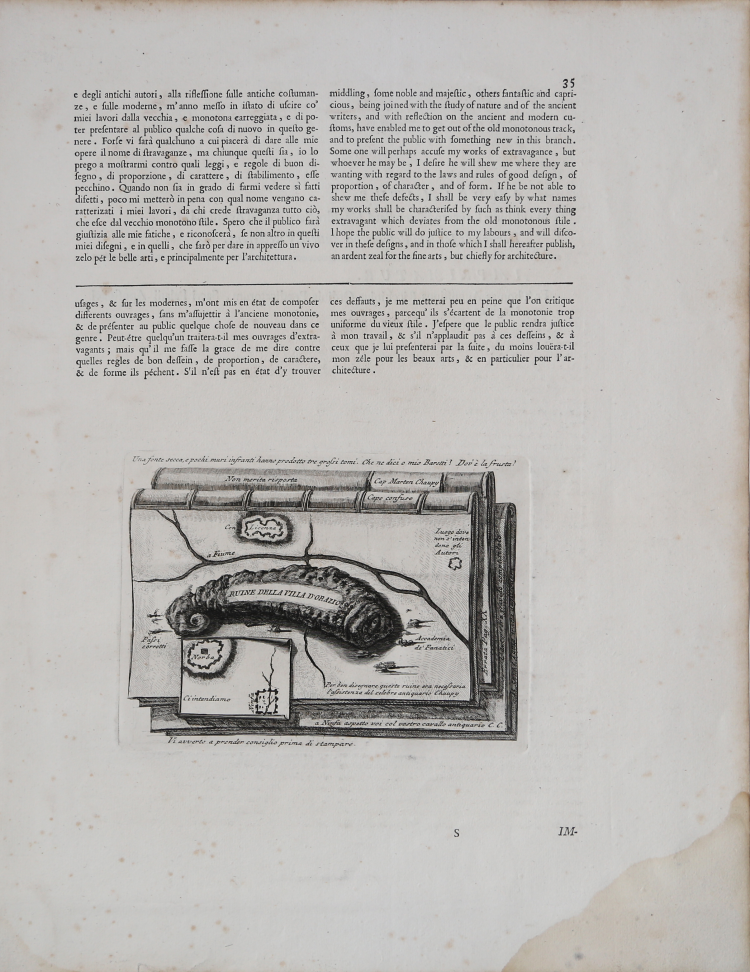




| Reference: | S31752 |
| Author | Giovan Battista PIRANESI |
| Year: | 1769 |
| Measures: | 218 x 160 mm |



| Reference: | S31752 |
| Author | Giovan Battista PIRANESI |
| Year: | 1769 |
| Measures: | 218 x 160 mm |
The embarrassment in describing the subject is equal to all the Piranesi's artistic and intellectual inspiratrion, summarized by this "vignette" with a curious but unmistakable shape!
Very rare work, with a satirical and polemical insiration, inserted on page 35 of the only first edition of "Diverse Maniere d'adornare i Cammini ed ogni altra parta degli edifizi, published in 1769 in Rome.
Exactly the work is located at the end of the Apologia in difesa dell'architettura degli Egiziani e Toscani, made in open dispute with Bertrand de Capmartin Chapuy, author of a text on archaeological villa of Horace entitled "Decouverte de la maison de campagne d 'Horace" and printed between 1767 and 1769.
Continuing the open dispute with the so-called "scholarly archeology", Piranesi in his Apologia which comes before this print, keeps on and intensifies the thesis which he initiated with the "Antichità Romane".
The three depicted volumes give rise to a trompe l'oeil effect; the name of Capmartin de Chapuy is shown on one of the three volumes, with a few monking sentences directd towards him as :"Non merita risposta" & "Capo confuso" ("He does not deserve response" & "Cape confused").
These are enriched by the iscription "Una fonte secca e pochi muri hanno prodotto tre grossi tomi" ("A source dry and few walls have produced three thick volumes").
Below, the author takes care to advise the publisher with the inscription: "Via avverto a prender consiglio prima di stampare" ("I advise you to think about it carefully before printing").
Etching and engraving, 1769. Magnificent proof, printed on contemporary laid paper with watermark "double circle and lily with letters CB" (Robison 37), with full margins, slight water stain at the bottom right of the white margin, in excellent condition.
|
Focillon 856, Witon-Ely 817
|
Giovan Battista PIRANESI (Mogliano Veneto 1720 - Roma 1778)
|
Italian etcher, engraver, designer, architect, archaeologist and theorist. He is considered one of the supreme exponents of topographical engraving, but his lifelong preoccupation with architecture was fundamental to his art. Although few of his architectural designs were executed, he had a seminal influence on European Neo-classicism through personal contacts with architects, patrons and visiting artists in Rome over the course of nearly four decades. His prolific output of etched plates, which combined remarkable flights of imagination with a strongly practical understanding of ancient Roman technology, fostered a new and lasting perception of antiquity. He was also a designer of festival structures and stage sets, interior decoration and furniture, as well as a restorer of antiquities. The interaction of this rare combination of activities led him to highly original concepts of design, which were advocated in a body of influential theoretical writings. The ultimate legacy of his unique vision of Roman civilization was an imaginative interpretation and re-creation of the past, which inspired writers and poets as much as artists and designers.
|
|
Focillon 856, Witon-Ely 817
|
Giovan Battista PIRANESI (Mogliano Veneto 1720 - Roma 1778)
|
Italian etcher, engraver, designer, architect, archaeologist and theorist. He is considered one of the supreme exponents of topographical engraving, but his lifelong preoccupation with architecture was fundamental to his art. Although few of his architectural designs were executed, he had a seminal influence on European Neo-classicism through personal contacts with architects, patrons and visiting artists in Rome over the course of nearly four decades. His prolific output of etched plates, which combined remarkable flights of imagination with a strongly practical understanding of ancient Roman technology, fostered a new and lasting perception of antiquity. He was also a designer of festival structures and stage sets, interior decoration and furniture, as well as a restorer of antiquities. The interaction of this rare combination of activities led him to highly original concepts of design, which were advocated in a body of influential theoretical writings. The ultimate legacy of his unique vision of Roman civilization was an imaginative interpretation and re-creation of the past, which inspired writers and poets as much as artists and designers.
|